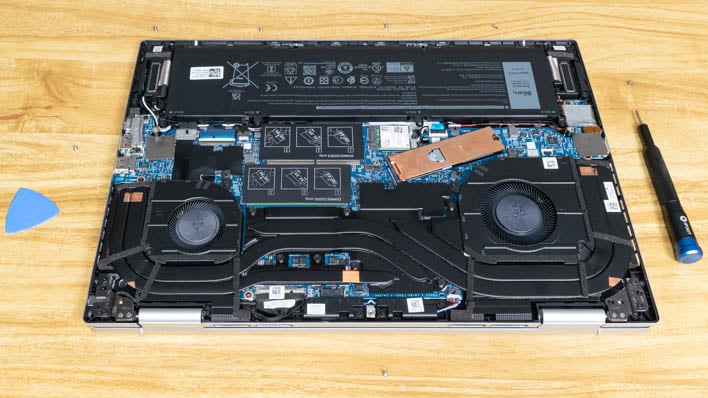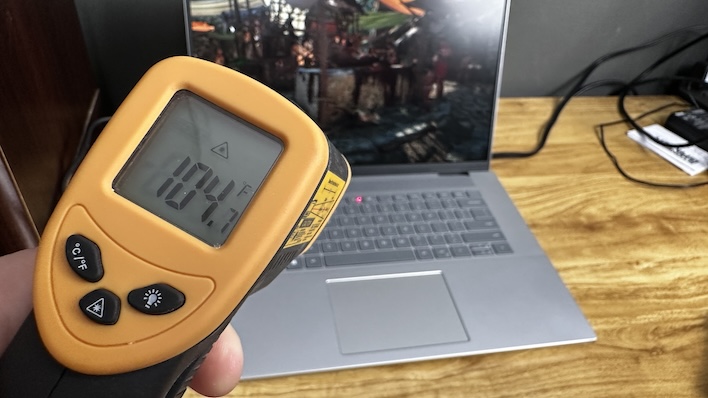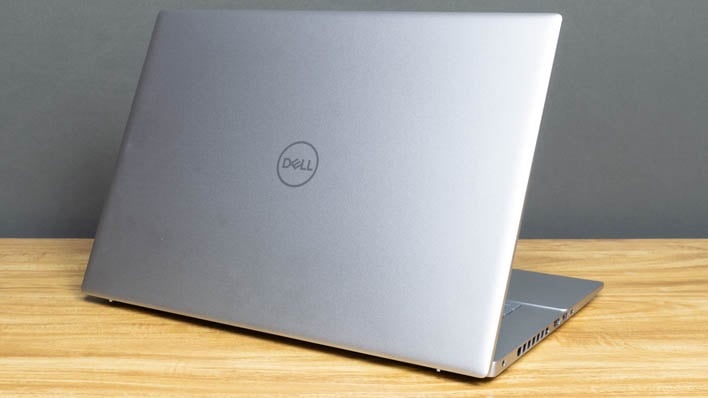Dell Inspiron 16 Plus Laptop Review: Understated Beauty And Brawn
Dell Inspiron 16 Plus (7630) Battery Life

The battery life on the Inspiron 16 Plus is solid. We got right at five and a half hours on the battery, in line with other notebooks with this same hardware configuration, like the ASUS Vivobook 16 Pro.
PCMark 10's Video Playback battery test does basically the same thing, but with UL's own video player and media file stored locally. It tends to run just a tad longer than our test, but not by much.

Here we get an extra 17 minutes on the battery, nothing exceptional to write home about. Still, approaching six hours of video playback is very good, and the Inspiron 16 Plus's 86 Wh battery acquits itself nicely. That's not too far off of the larger Dell XPS 17 (9730) and trails the Dell XPS 15 (9530) by a bit more, but that 15-inch laptop has just a 40 Watt GPU.
Dell Inspiron 16 Plus (7630) Thermals
Let's tear down the system and see what keeps it cool...After removing some Torx T6 screws and gently prying on the bottom of the enclosure with a guitar pick, the bottom cover of the system comes off and we can see the lay of the land. First and foremost, we can see a pair of fans and a network of heat pipes that pull heat from the CPU and GPU and push them out the side vents of the system. The air that comes out of the vents we only measured to be around 110° Fahrenheit under a full load, which is warm on the mousing hand but not unbearable or even uncomfortable, but more on thermals in a moment.
We can also see the dual DDR5-4800 SO-DIMMs and 1 TB M.2 2280 SSD that are easily replaceable by anyone adventurous enough to upgrade the system by themselves, along with an M.2 Wi-Fi and Bluetooth card. These all score high marks in our book. And then above that sits the 86 Wh battery and a pair of downward-firing speakers that complement the two upward-firing ones that make up the Inspiron's sound system.
To put a load on our system, we looped the Shadow of the Tomb Raider benchmark a couple of times to get the fans going as much as possible. In the Optimized profile, we measured a noticeable but not overly-loud 47-48 dBA. But when we pushed the system as hard as we could with the Ultra Performance power profile, which did net us around 10% on this benchmark, we measured up over 53-54 dBA. These measurements are taken at around 18" from the display, right where our face might be while leaned in for an intense gaming session. While the fans do make some racket, we could cover that up easily with a headset. Since the speakers aren't the greatest, the headset makes for a better experience, anyway.
As for surface temperatures, the system wasn't hot to the touch. Subjectively we had no problems using the keyboard or mouse. As we said, hot air vents out the side, and it's warm, but that 110°F isn't too bad. Surface temperatures are better, though, maxing out a little bit lower at 103-104°F in the hottest spot we could find in Ultra Performance mode. And Optimized was about the same for both exhaust and surface temps, just not as loud and not quite as fast.
Dell Inspiron 16 Plus (7630) Conclusions
Not everybody wants to spend a fortune on premium materials, ultra-thin form factors, or gaming behemoths full of RGB accents, featuring 200 Watt power bricks. Most users would probably do well with a mid-budget, jack-of-all-trades kind of laptop and that's exactly what the Inspiron 16 Plus is. It can play the latest games, run all the productivity software anybody needs in a laptop, and the battery life is pretty great.It's not the thinnest laptop out there, and it's not made from high quality aircraft aluminum, but it's also not $2,000 as a lot of those machines would be. Instead it's about $1300 today (sometimes on sale for less) and it's got plenty of legs for all but the most demanding of users. It does get kind of loud under load if you use the ultimate performance profile, but the temperatures never get out of hand, so that's a trade-off we can live with. And just because it's not expensive doesn't mean it's built cheaply; the PCA plastic shell is sturdy and looks nice, too.
The Inspiron 16 Plus starts at $999, but that machine is a far cry from what we tested here. There's a Core i7-13620H, Intel UHD graphics, 16 GB of LPDDR5 soldered memory, and a 1 TB SSD in the base config. Users can swap over to user-upgradeable SO-DIMMs, the GeForce RTX 4060 with 8 GB of VRAM, the Core i7-13700H, and the same storage for $1,299. Dell told us that this review unit configuration is routinely on sale for $1,249 or $1,349 with 32 GB of RAM, too. Either way, you get the 1600p WVA display with a 120 Hz refresh rate, the 1080p webcam, and excellent battery life. Unless you absolutely never need to game and have to stick to as low a budget as possible, the upgraded model is a no-brainer, in our opinion.
While it's easy to get spoiled working at HotHardware by test driving the sleekest, fastest, or most premium laptops around, the truth is most users either don't want to spend that much or don't need that kind of portability or power. The Inspiron 16 Plus site in the happy middle ground where it's light enough to tote, fast enough to game, and inexpensive enough to save a whole lot of money. It's also got excellent battery life considering its specs, and the display is hard to beat in this price range. For buyers who need a machine to do a good job of just about everything and not break the bank, we definitely recommend the search start with the Dell Inspiron 16 Plus.











